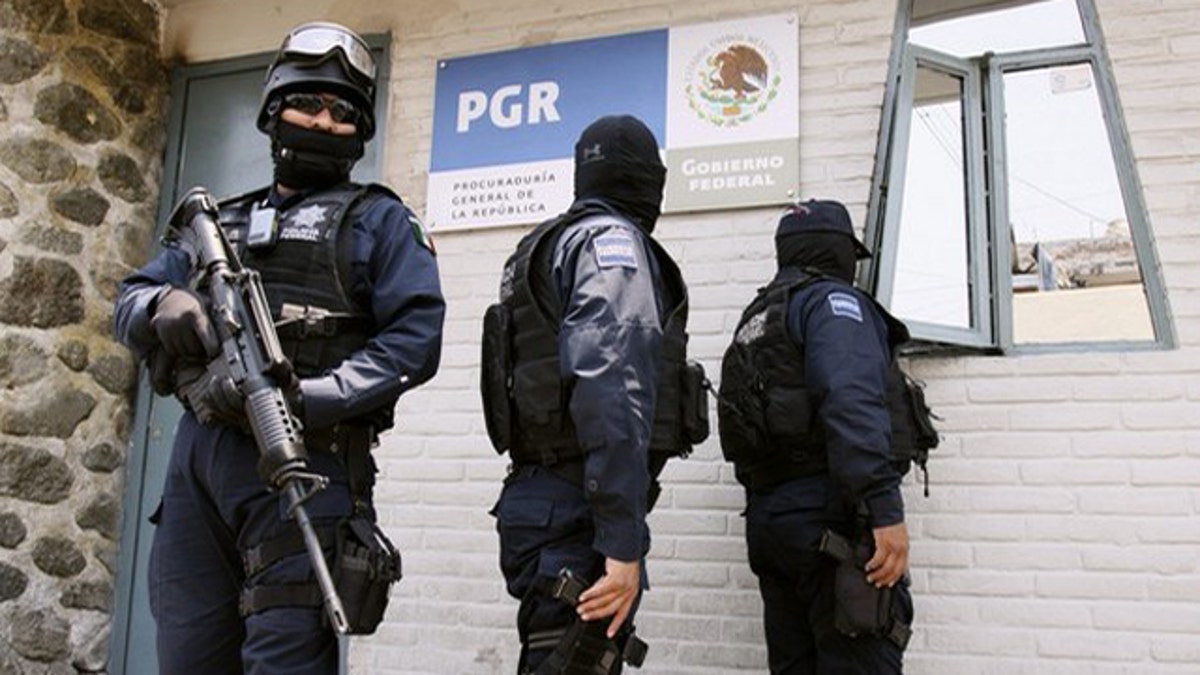
May 19: Federal police stand guard outside the Attorney General's office (PGR) in Cuernavaca after the arrest of Victor Valdez, known as "El Gordo Varilla" (The Big Stick). (Reuters)
There are places in Mexico where residents don’t know who the real police are.
Shadowy kidnappers and men committing grisly crimes in broad daylight are often dressed in formal police or military gear, suggesting no difference between the good guys and the bad guys, between the drug cartels and the government trying to stop them.
According to a growing number of reports out of Mexico today, the major drug trafficking operations (DTOs) – like Los Zetas, the Gulf Cartel, La Familia Michoacana and its latest incarnation, Caballeros Templarios (Knights Templar) -- are not only donning uniforms but brandishing insignias, badges, even decals on their vehicles that are indistinguishable from that of the federal or local police forces.
“This has been going on for about five or six years and perhaps even longer – members of Mexican cartels impersonating the cops … or dressed in some sort of dark, scary uniforms,” said Howard Campbell, a professor of anthropology at the University of Texas El Paso.
“They want to wear the disguise that will allow them to carry out their activities more successfully,” noted George Grayson, author of "Mexico: Narco-Violence and a Failed State?"
He pointed to a rash of successful prison escapes two years ago in which members of Los Zetas dressed in police and federal uniforms to help spring fellow members from jail. According to reports, the Zetas pretended to carry out “inspections” and, with aid from guards on the inside, were able to get to the inmates, open the cells and allow them to just walk away.
In one of the most notorious cases, Zetas dressed up like members of the Federal Investigation Agency (AFI) and had successfully released their friends from a prison in the northern state of Zacatecas within five minutes.
“They accomplished a blitzkrieg of a prison escape, aided by those uniforms,” said Grayson, who noted that “there is a big black market for military uniforms” and other official gear, including weapons, in Mexico today.
More recently, Mexican police are still looking for the gunman behind the brazen daylight murder of U.S Immigration and Customs Enforcement (ICE) special agent Jaime Zapata in February in San Luis Potosi.
Reports say Zapata and fellow ICE agent Victor Avila, who was wounded in the attack, may have stopped their armored SUV and rolled down the driver’s window before they were shot, suggesting they believed they were being approached by friendly forces. Police are looking at members of Los Zetas as possible suspects in the case, according to news reports.
Subterfuge like this is not new – even insurgents in Afghanistan have been known to use official military or police uniforms in bold attacks against coalition forces. In Mexico, where the reputation of the police is almost as bad as the gangs themselves, it is smart strategy. It confuses witnesses.
“The default position is you always suspect the police are engaged in illegal activity, so it would not surprise the average Mexican one scintilla to see a ‘police officer’ committing a crime,” Grayson said.
But Campbell points out that the DTOs are not only employing the uniforms and insignia as tactical deception. They are using them out in the open to identify themselves in places where the gangs have nearly total control. Increasingly, the gangs are becoming the government, and they are taking their new roles very seriously, he added.
“They might as well wear uniforms because they are the people in charge,” said Campbell, noting the uniforms serve at least two different functions -- to intimidate local residents and to reflect a system of hierarchy and pride among members.
A video released in April by the Mexican blog Videos Policiacos shows at great length the official patches and insignia of the Zetas, the Gulf Cartel, Knights Templar and their regional affiliates emblazoned on hats, shirts, flak jackets, trucks and SUVs – plus endless caches of weapons, helmets and other security gear – including gold-plated AK-47s and diamond encrusted handguns.
See video below:
Experts say this is only a reflection of how badly the Mexican government’s war against DTOs is failing today. Last year, Mexican lawmakers admitted that some 71 percent of municipal governments in Mexico were under the influence of criminal organizations. The drug-related death toll in 2010 hit a new high of 15,273, compared to an estimated 2,800 in 2007, according to numbers released in January.
Government officials continue to insist that the drug war is working and that the high body count reflects the government taking the fight directly to the cartels.
Alejandro Poire, President Felipe Calderon's spokesman for security issues, told The Dallas Morning News recently that 20 out of 37 top cartel leaders identified by the government have been brought down in the last two years. “These criminal organizations have been weakened, have been significantly weakened," Poire said.
Though Poire denies it, experts like Campbell say the northeastern gulf state of Tamaulipas – where a total of 183 bodies in mass graves were found this spring -- is completely overrun by DTOs, particularly Los Zetas. Similarly, multiple cartels have been fighting for control of Ciudad Juarez, a murder-wracked city in Chihauhua state located right across the border from El Paso, Texas.
Recent reports have highlighted the Zetas’ control of Nuevo Laredo, a Tamaulipas city also near the Texas border. In effect, the gang taxes and regulates the operation of local businesses through extortion, steals from or rations local resources like gasoline and imposes order through an elaborate network of spies and enforcers, says Campbell.
The gangs outfitting themselves like the government is just another way for them to announce that the official Mexican leadership has lost its authority in those places.
“This is not only about drug running,” Campbell said, “but about becoming regional powers repackaging the Mexican government.”
